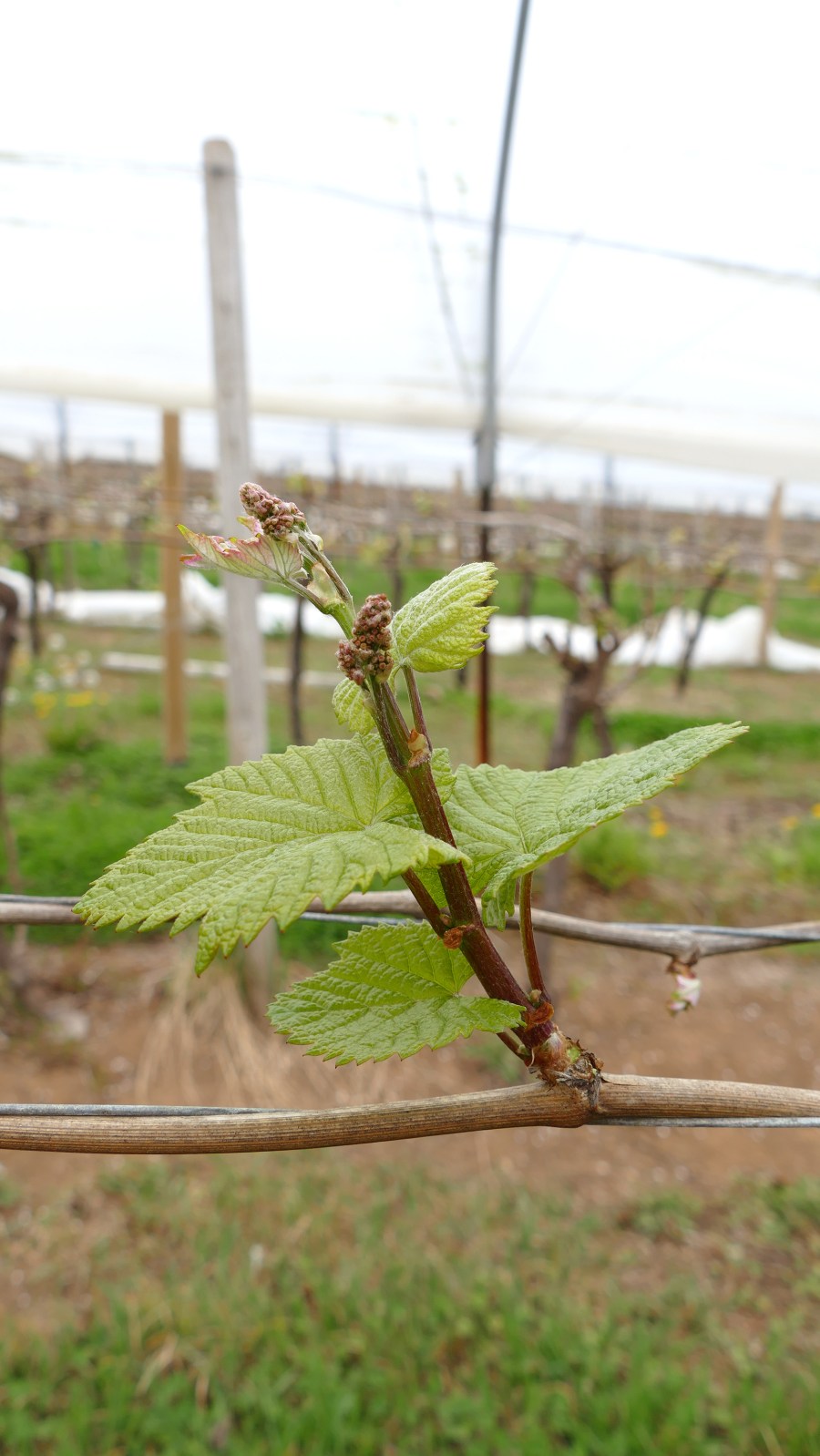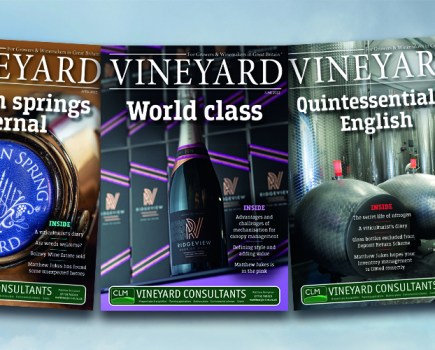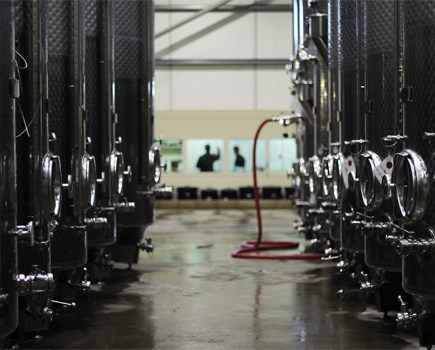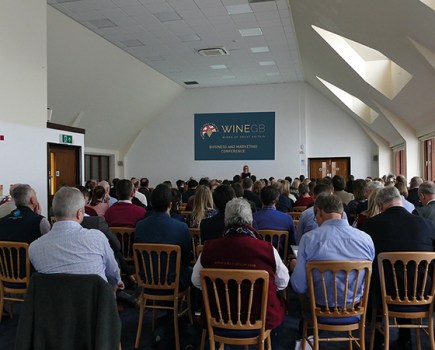For the majority of my journey down the A30 to Cornwall’s coastal town of Penzance, I was surrounded by a blanket of thick fog. Although this had lifted by around midday, as I stepped into Polgoon’s vineyard with owner John Coulson, I couldn’t help but notice that there was still a dampness hanging in the air.
“Today is perfect disease weather,” said John in response to me showing him my disappointing photograph of Land’s End. “The biggest challenge here in Cornwall is the moisture and the rain. We have good growing conditions, with lots of sunshine but that moisture content means we are more prone to disease in the vines, especially early season Botrytis which you don’t often see in the rest of the country.”
With John estimating that growth was a week or two behind an average year, like other vineyards across the country by my visit on 24 April the vines in England’s most westerly mainland vineyard were starting to come to life, with Rondo, the earliest variety at Polgoon, showing signs of bud burst. But that was just in the ‘outside’ vineyard.
As we rounded the corner, Polgoon’s polytunnels came into clear view and wandering into the white structures it was immediately clear to see a phenomenal difference in growth, with the Rondo displaying unfolding leaves and early inflorescence formations.
Alongside the visual impact, walking further towards the centre of the tunnel it was soon apparent how much difference there is in the climate, from the increased temperature, to the dryness of the air and the lack of coastal breezes.
“The polytunnels make a huge difference,” said John. “It is Polgoon’s best kept secret. Seven or eight years ago we were consistently not cropping because of disease pressure and were really struggling. My sister-in-law runs a very successful business in Devon and she wanted to help, so her business invested in some polytunnels from Haygrove. We put up the first five tunnels at the top of the site and today we have about 40 polytunnels covering our range of varieties.”
Even outside the tunnels, looking up the rows it was clear that their effect lasts for the first two or three posts before the growth begins to reduce again. While it was very impressive to compare the development stages between the same variety planted in the same field, John confirmed that this infrastructure would probably only stack up financially for those with serious growth restrictions or disease pressure.
“The polytunnels were a massive investment and only worth it from the point of view of someone who was stupid enough to plant vines by the coast in Cornwall,” said John. “We do make savings in other areas, so we use half as much spray in the tunnels as we do outside, and we don’t get the same weed pressure, but I doubt it would be viable for other growers, especially those in the South of England.”
As well as utilising the polytunnels to stave off disease, John, with input from local viticultural consultant Richard Smart, has been experimenting with cloches, a polyethene film which covers the vines on both sides.
“Richard has done all the research and work on the cloches,” said John. “We have played around and adapted the system ourselves. We have just started to put them up and will pull the cover up in the next week or so.”
Working with Richard, John also showed me his trunk renewal system trials. The aim is to eradicate Polgoon’s problems with trunk diseases that weaken the vines to the point where they either die or become quite hard to crop, with lots of unripe small berries produced due to the lack of leaf formation.
“10 years ago, we did a number of large pruning cuts and we think that disease has got into the vine from those cuts and has started to spread throughout the trunk,” said John. “Richard has come up with the idea of growing a renewal trunk which in theory won’t be carrying disease. We have been lucky to work with him and tap into his knowledge. It has been very interesting working with one of the world’s leading viticulturists and being able to do some research.”
Flowers to fruit
Before diving into viticulture and vinification, John and Kim Coulson were fish merchants operating from the Cornish fishing town of Newlyn. With six children, the growing family needed to find a bigger home and soon discovered the farmhouse at Polgoon was for sale.
“The old farmhouse on site was built in 1803 and we fell in love with it,” said John. “Our offer was accepted but the owner said that the surrounding land was going to be sold and turned into an industrial estate. We knew the only way to control what was built was to take it in hand ourselves and try to develop it. We ended up buying it all in 2002.”
After inviting local grower Bob Lindo, owner of Camel Valley, to view the site and gauge whether it could be turned into a vineyard, John got the soil tested, bought some vines and planted in 2004.
“Initially we took advice from a few consultants, but we decided after a few years that it was best to just make our own way because no one had ever grown vines here before,” said John. “You could spend a lifetime reading books and researching it but if you don’t have the courage to go ahead you’d never do it.”
Previous to the Coulsons moving in, the traditional Cornish sandy loam granite hillside at Polgoon had been used to grow flowers and consequently a lot of nitrogen had been put onto the soil over the years leading to exceptionally vigorous vines.
“The vines are like gangly teenagers with a lot of growth but not necessarily enough fruit, so we have tried to address that balance,” said John. “We take petiole and soil samples annually and either put down floor dressings or apply foliar feeds. It is a big part of our vineyard management because if you can’t create the situation where the vines are happy then you will struggle.”
As well as correcting deficiencies in magnesium and boron, in the fight against early season Botrytis, John also finds that calcium foliar feeds help to increase cell strength, producing a hardy, more disease resistant vine.
Diverse range
Today the 21-acre estate has 15-acres under vine, with Bacchus, Ortega, Pinot noir, Pinot noir précoce, Rondo and Seyval blanc used for still and sparkling wine, along with an orchard planted with 10 dessert varieties for cider and juice production.
“In 2008 and 2009 we had very little crop and having the diversification into cider really helped to keep the business going,” said John. “Now, we are getting a crop from the vines every year and are making a diverse range of award-winning wines, but it is still good to know that we are not reliant upon wine and the cider has become a core part of the business with key customers such as Bill’s restaurants.”
Focused on selling the Cornish wines, ciders and juices to the local trade, as well as tourists, John believes that it is key for the estate to be able to produce a diverse range of wine styles, and while Polgoon does produce a traditional method sparkling, the still rosés, dry whites and reds (in a good year) are the focal point.
“There isn’t necessarily a huge market for sparkling wine where we are in Cornwall and a big part of that has already been taken by well-established vineyards, so we have needed to have a cross section of wines to make it work,” said John.
“The trouble with English sparkling wine is that everyone is growing the same thing and doing the same thing with it. I can’t understand that. We have an opportunity in this country to do more than make sparkling wine and pat ourselves on the back about how good it is. We, as well as a lot of vineyards in this country, make some wonderful Bacchus and there could be so much more focus on that than there is.”
To further set themselves apart from the crowd, the next development on the horizon for Polgoon is Sauvignon blanc. With two acres planted under polytunnels, last year’s crop produced around 200 bottles and John is anticipating that a successful 2018 growing season will see the first commercial release of a few thousand bottles.
“It is going to be interesting to see how it turns out because there are so many different styles of Sauvignon blanc around the world,” said John. “It will be a Cornish Sauvignon blanc too, not just English. There are English producers who have blended it but they haven’t had enough to do it on its own, so I am quite hopeful that we have something reasonably unique coming up. It will just be a great addition to our range.”
Community engagement
As well as being the only vineyard located on the A30 route to the popular visitor destination of Land’s End, Polgoon thrives on the area’s tourism and food and drink scene, with around 40% of sales made through the cellar door shop.
“Wine tourism is so important to Polgoon,” said John. “Getting people here to experience the tour and to see how we produce the wine is a massive part of our business. We have just put new signage up on the road and have opened a kitchen recently. We have even put on some tours in the Cornish language because we want to provide people with something unique that they will only experience here.”
Currently the vineyard collaborates with local hotels, restaurants and pubs to drive and improve awareness among those who are on holiday in the area and as other producers around Great Britain begin to launch cooperative groups John believes that one day the Cornish vineyards could do the same.
“There are not as many vineyards in Cornwall and there is quite a large geographical spread so at the moment we don’t collaborate with other vineyards on the tourism but there is potential to do so,” said John. “It is something which we talk about in the office. We have good links with Visit Cornwall and perhaps they could help to coordinate. It has potential to work but someone at the end of the day has to pull it all together.”
As well as collaborating with local businesses, Polgoon has also developed strong links with the local community and produces a limited-edition range of Bacchus which aims to capture the local environment and Cornish landscape through art.
“Working with Newlyn Art School we produce 1,500 bottles of Art for the Bacchus,” said Clare Woodhouse, marketing manager at Polgoon. “Each year we choose a different painting from one of their artists for the bottle label. This year we chose Veor Cove by Paul Lewin because it is exactly how you imagine Cornwall to be and having been fish merchants in their early years, Kim and John have a real affiliation with the sea.”
Popular with tourists for souvenirs and gifts, Clare has also found that the label provides the local trade, particularly restaurants and hotels, with a captivating story and something special for them to talk to their customers about.
All about the fruit
Annual production at Polgoon reaches between 20,000 to 25,000 bottles of still and sparkling wine from the estate’s 15-acres of vines, with a further 5,000 to 10,000 bottles produced from fruit from other vineyards. This includes contract made wine and also some bottled under the Polgoon brand.
“We have a very good relationship with Alder Vineyard,” said John. “We use their Madeline angevine for our own label and they trust me to make their wine for them because at the moment they don’t have their own winery. We are pretty much up to capacity in the winery and I am happy if we can keep on producing 30,000 to 35,000 bottles of wine per year.”
At harvest time all the fruit is passed through a small press graded at 1,200 kilos. While John tells me that it can be manic to get through over 40 presses, the polytunnels and cloches in the vineyard provide some relief, with fruit across the vineyard ready in various stages. Last year harvest started at the beginning of September and ran through to mid-October with Seyval blanc being the last variety to be harvested.
“At some point we may look at getting a bigger press,” said John, “But they’re not cheap and I am happy with the way ours performs. It is not too brutal and, in some ways, I am scared of changing it. It is like that old reliable car.”
Apart from sticking with the original press, over the past five years John tells me that a lot of work has been focused on improving the quality of the wines and a great deal of time and investment has been put into the winery.
Alongside two gyropalettes sits a crossflow filter which John claims is the best piece of equipment he has ever bought because of how much time it saves. The main tank area is very tidy and together nestled in an insulated Kingspan box, which would normally be used as a walk-in fridge.
Floral characters
“This is an insulated room and all the tanks are refrigerated so we can slow the fermentation process right down,” said John. “We have just gone through cold stabilisation in the last month and have been running in here at about 2 or 3 degrees. We are really focusing on the floral characters of the wine and trying to extract as much of that as we can through the process.”
Opting to teach himself winemaking, John has been learning on the job over the past ten years and believes that it is all about the fruit, not just in terms of sugar levels, acidity and lack of disease, but also in terms of the character.
“We will bottle the wines in the next month or so,” said John. “I am really pleased with all the wines from last year; that is three years now in a row where we have had the same cleanliness to the fruit and the fermentations. It is down to having the experience and being able to focus on the fruit. This is the wine we want to make and the wine we believe in.”
Having already discussed John’s views on the English sparkling wine movement he explains that for the Seyval blanc, which is used as the base for Polgoon’s Brut Sparkling, he uses an ordinary yeast for the first fermentation to try and get a little bit more fruit coming through to produce a different style of English sparkling wine.
The 2017 still rosé has this year seen a slight recipe change to produce a slightly lighter version with a small amount of Seyval blanc blended with Rondo to give a delightfully juicy strawberry, with a hint of tart cherry character.
“For me it is very Cornish,” said John. “We have been producing consistently good rosé for 12 years and the first wine which Sam Lindo at Camel Valley made for us won the trophy for the best rosé in the country in 2006.”
Running through the other wines in the tanks the Bacchus has a lot of fruit punching through it with big elderflower flavours. The Pinot noir which will be used for the sparkling blend was typically strawberry bound and the Rondo red was soft and clean.
“It is really hard because everyone who walks into the shop wants a red wine,” said John. “But I won’t make one unless I have the fruit which I think will do it justice. In 2015, we didn’t make a red, but we have nearly 7,000 bottles of red wine from last year. I am at a quandary of whether to put a little bit of oak into it or whether we just leave it clean and fruity. We oaked a red in 2014 I think, and it can bring just a little bit of complexity to it.”




